SaaS B2B Facebook Ads – How To Drive Leads In A Cookieless Future
Written by: Gabriel Solberg Read time 7 minutes
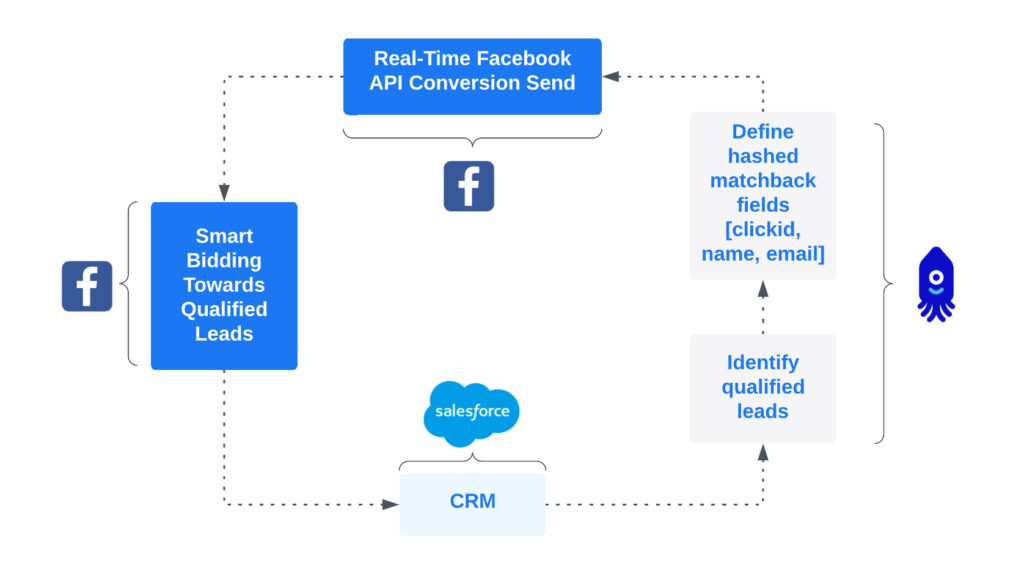
Getting SaaS B2B Facebook Ads right is hard. Facebook, a platform that delivers ads at scale, across targeted audiences, is fundamentally the opposite of targeted B2B marketing. As a result, the challenge with Facebook Ads for B2B advertising is not driving leads. The challenge lies in how to drive high-quality leads with a propensity to convert.Below we explore the limitations and challenges of running SaaS B2B Facebook Ads and how you can win with B2B marketing on Facebook with ConversionStream.
B2B Facebook Audience Limitations
Facebook audiences can be somewhat tailored to business intent. However, audience size directly impacts Facebook Ad performance. While hyper-focused audiences make sense for B2B marketing, the algorithm needs a larger data set to effectively optimize for conversions. This is especially true, post-iOS 14.5, now that Facebook uses an aggregated event measurement model.
Facebook is also continuing to remove access to audience data. In July of 2021, they shuttered audience insights and transitioned to Business Suite Insights. The main difference? You can only view your audience insights as opposed to all audience insights. In addition, Facebook is NOT allowing some accounts to opt out of audience expansions. Again limiting audience targeting, control, and granularity.
Broad audience targeting goes against focused B2B advertising on Facebook or other platforms. However, given Facebook’s recent changes, targeting smaller audiences is ineffective and feeding the algorithm high-quality leads data is critical for scale and success.
Optimizing Your SaaS B2B Facebook Ads For Leads
Facebook’s algorithm, despite the iOS 14.5 changes, continues to be very effective at finding people with a high probability to convert. However, Facebook’s algorithm is only as good as the data you feed it. Low quality leads = garbage in garbage out.
Relying on leads as your primary conversion action provides a weak signal. Without any lead scoring or lead enrichment data Facebook cannot identify the quality and value of each lead. As a result, the Facebook algorithm will think it’s doing a great job as long as people are filling out a form.
This forces the optimization process into a manual feedback loop where you take action on directional data and assumptions. What you get is a manual Salesforce Facebook optimization feedback loop like the one pictured below.
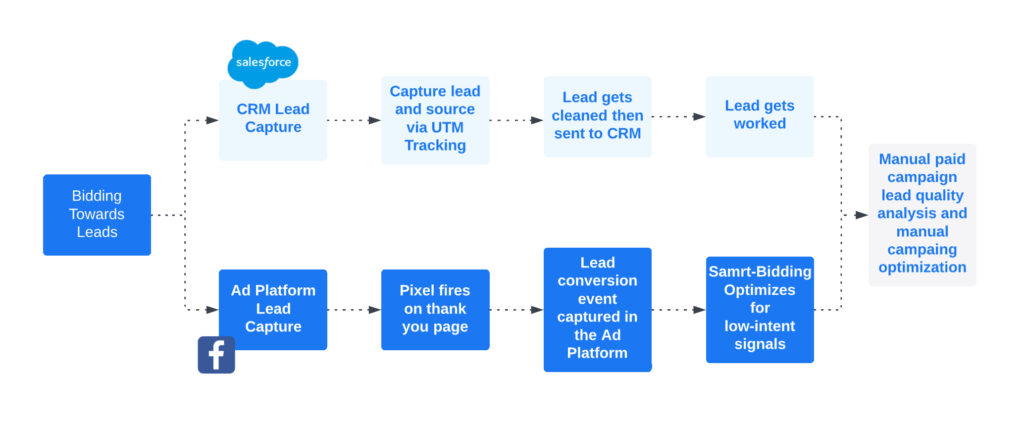
In an ideal world, you want to send enriched lead data back to Facebook so that Facebook’s algorithm can optimize for both quality and value in real-time.
How To Win With B2B Marketing On Facebook
How can you win with B2B marketing and generate qualified leads on Facebook working with limited audience targeting and weak conversion signals?
The key is to send quality and value-based conversion signals back to Facebook in real-time. This creates a real-time value-based Salesforce Facebook optimization feedback loop.
The solution? Send Salesforce marketing qualified leads as conversion signals back to Facebook. However, a marketing qualified lead by itself doesn’t provide a ton of value. What if you could only send conversion signals for enriched marketing qualified leads using additional attributes? Imagine a world where you can optimize for high-quality leads based on their lead score, potential revenue, or estimated company size.
Leveraging enriched data ensures that you only send high-quality and high-value conversion signals back to Facebook Ads. Consequently you get a quality data feedback loop where Facebook’s algorithm can optimize for high-quality conversions in real-time. In addition, by sending conversion values back to Facebook, you can use a value-based bidding model. Each lead does not hold the same value, and optimizing solely for an average target cost per lead creates lost opportunity.
SaaS B2B Facebook Ads Optimization vs. Measurement
One quick note on creating enriched lead feedback loops. Data aggregation falls under two categories:
Optimization – Conversion signals used for optimization are restricted to a specific window of time so that the ad platform can leverage conversion signals for bidding optimization. Currently, for Facebook Ads this is 7-days.
Measurement – Conversion data outside the 7-day optimization window can be sent to Facebook using offline conversions. Facebook does not use these for optimization since their look-back window is 60-days. However, backfilling conversion data can be helpful for conversion measurement and analysis across campaigns, ad sets, and ads.
Sending Enriched Salesforce Leads To Facebook Ads In Real-Time
Sending enriched Salesforce leads to Facebook as conversion events in real-time is a huge unlock. Enabling the algorithm to optimize for high-quality and high-value leads makes it possible to scale SaaS B2B Facebook Ads. So how can you get Salesforce conversion signals and send them to Facebook in real-time?
Meet ConversionStream. With ConversionStream you select any object, field, and value for your custom Salesforce configuration and send this data in real-time to Facebook Ads via the Facebook Conversion API (CAPI). Keep reading to learn how to get started or explore product features here.
Two things to keep in mind before we get started:
🔄 Facebook Conversion API – Our system integrates with the Facebook Conversion API (CAPI) to send Salesforce events to Facebook in real-time. Facebook CAPI only accepts event data that occurred within a 7-day window. This ensures that Facebook can optimize against Salesforce events for conversion objective campaigns. Keep this in mind when selecting your Salesforce events.
📊 Aggregated Event Measurement – You do not need to configure Salesforce events for Facebook’s aggregated event measurement model. Typically you prioritize pixel based or pixel and server to server based custom or standard Facebook events for iOS 14.5 in your Web Events configuration. However this step is not required since conversions sent from ConversionStream are strictly server to server events.🔐 Security – For security and privacy reasons all PII information is hashed when our system pulls, process and pushes Salesforce data. We do not access, store or send any readable PII data at any time. You can view a full list of hashed values here.
Configure Your Salesforce Facebook Integration To Create A Conversion Feedback Loop
Let’s take a closer look at ConversionStream so that you can send quality lead conversion data directly to Facebook in real-time. Below, we are going to jump right to configuring Salesforce.
Note: To get instructions on creating your first Salesforce Data Stream you can watch a video here or follow the steps from this guide.
First, navigate to CRM Data Source and connect Salesforce.

Note: Our system defaults to the Lead object and the lead created date for the timestamp. You have the option to change the object as well as timestamp when configuring Salesforce. Typically we recommend using a timestamp that represents the date of the conversion or action.
After that, define the Lead Identifier Fields. Facebook will use these fields for customer match backs in their database. You have the option to include the Facebook Click ID (fbclid) as a lead identifier field but it is not required.
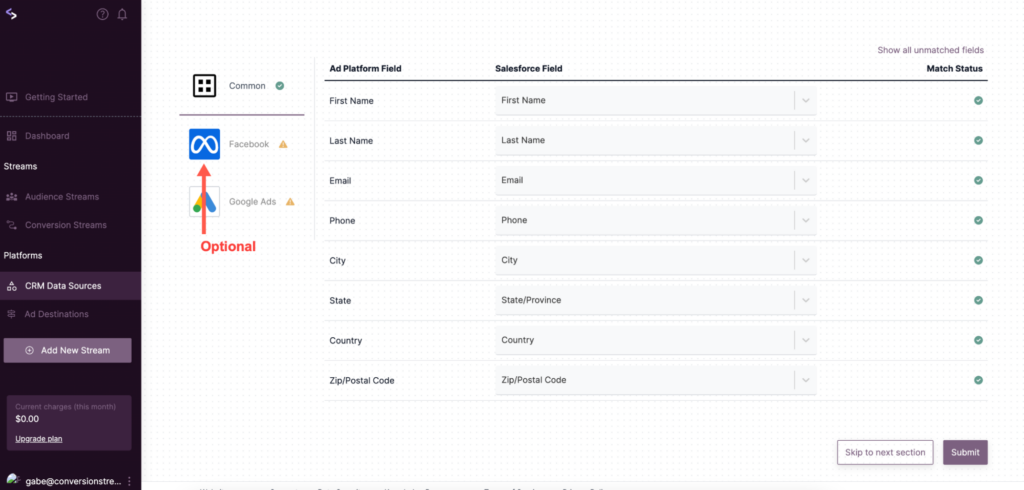
Now that Salesforce is configured you can create your conversion event.
Using Rules To Filter Down To High-Value Salesforce Leads
At this point, we have defined our Lead object and set the Lead Identifier Fields.
Now, let’s move on to selecting fields and field status/values that we want to include as conversions. In CRM Data source select the Conversion tab in the top right and click on +Add New Conversion Event
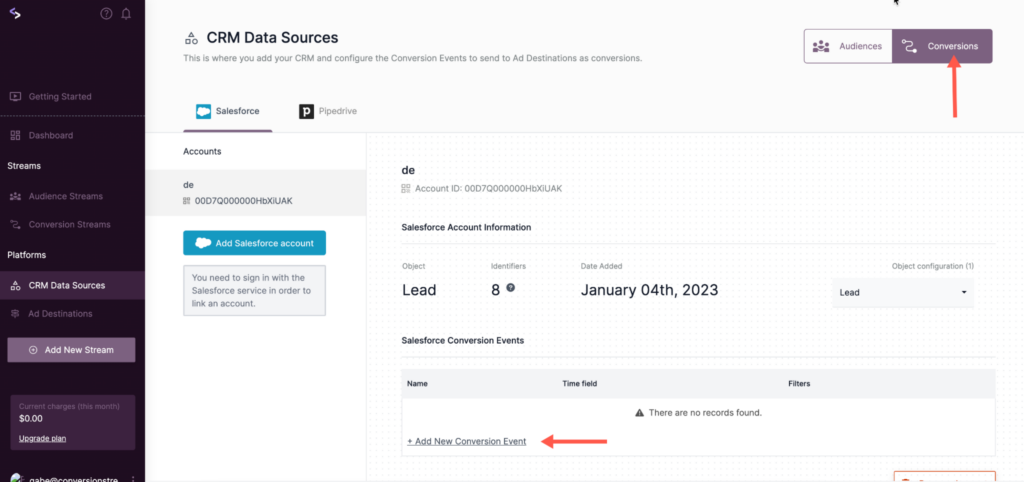
For example, let’s select the Status field and include all people that are Working – Contacted.

However, we only want to include high-value Working -Contacted leads. To only include high-value leads as conversions click +Refine Conversion Event
Now we can leverage the AnnualRevenue field and set a rule to only include leads with an assigned revenue value that is greater than $100K.
You can use any available field to refine your leads by value. In this example, we are using a revenue field. Another use case is to use the Company Size field.
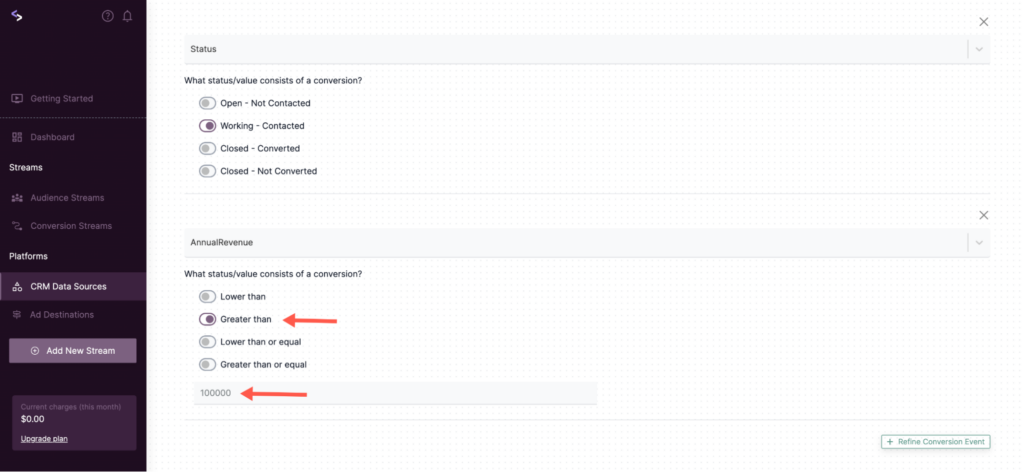
Click next and give the conversion event a name. The name you assign here will be the conversion event name that will be shown in the Facebook Ads Manager.
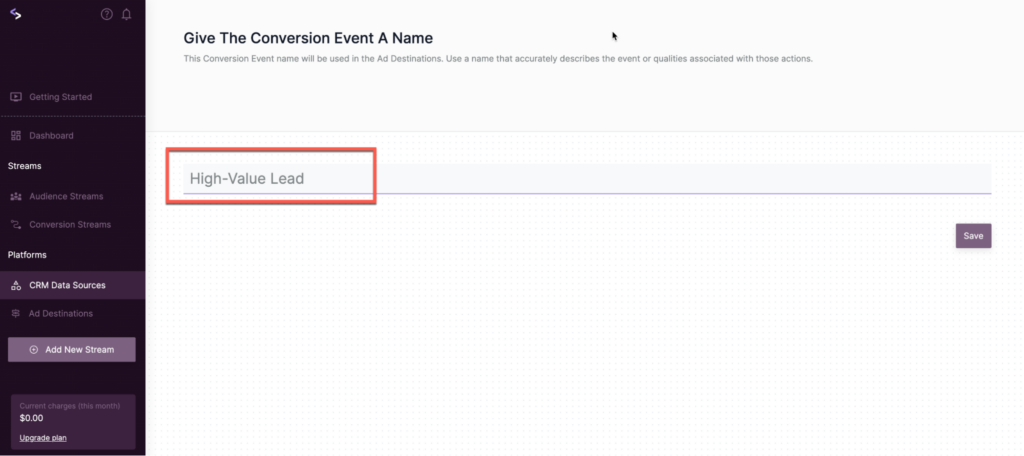
Now that you have your Salesforce conversion defined let’s configure the Facebook Ads integration.
Configuring Your Facebook Integration
Navigate to Ad Destinations and connect Facebook.
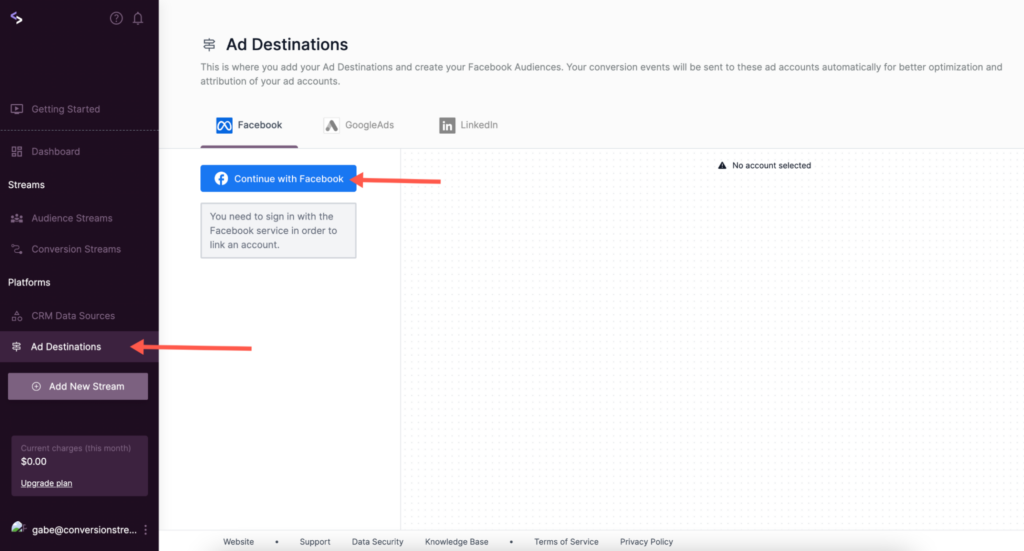
Next, select the +Add New Pixel
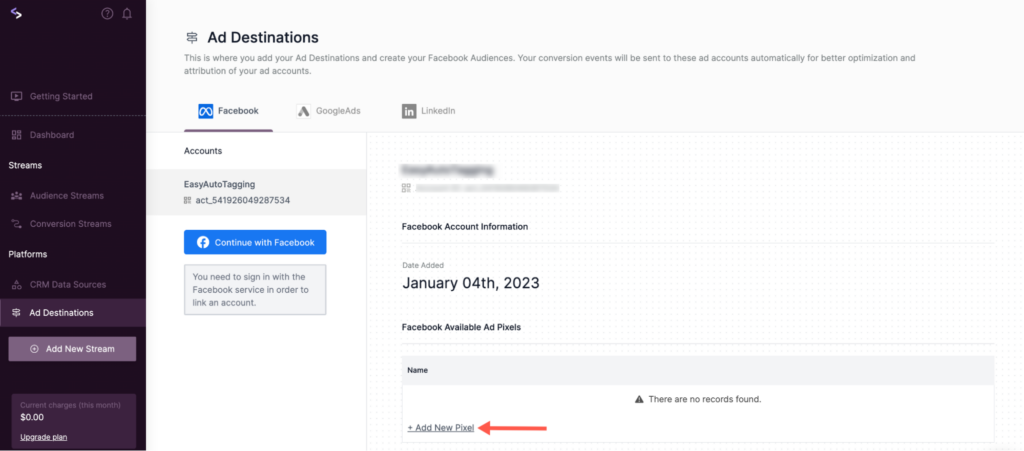
And select the pixel you want to stream conversions to. You can repeat this step for multiple accounts and multiple pixels.

Now that we have Facebook Ads configured let’s create our first conversion stream.
Configuring Your Salesforce Data Stream
With Salesforce configured, Facebook connected, and your conversion event created you can create your first conversion stream.
Navigate to Conversion Streams and click on Add new stream.

Next, select the conversion event that you configured in the prior step then select Facebook as your integration and choose the pixel you want to send the event to. Click save and you are done.
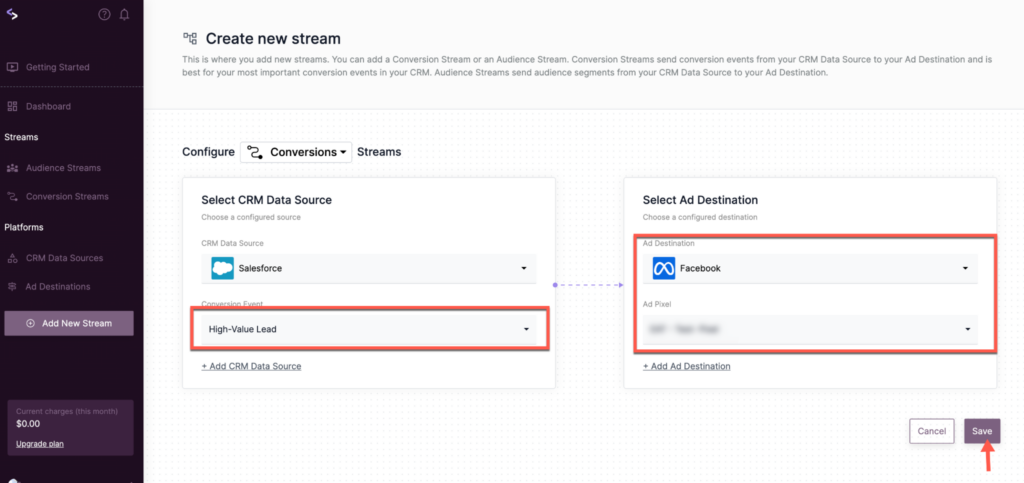
Finding your SaaS B2B Facebook Ads Conversion Events
To view conversion events our system sent to Facebook go to the Events Manager.
In the overview tab look for your Salesforce conversion event and expand the detailed view.Note: It can take up to 60 minutes after activating your first Salesforce Conversion Stream before events are available in the Facebook Events Manager.

Next, click on View Details > In the Event Overview tab and you can view the number of events streamed.
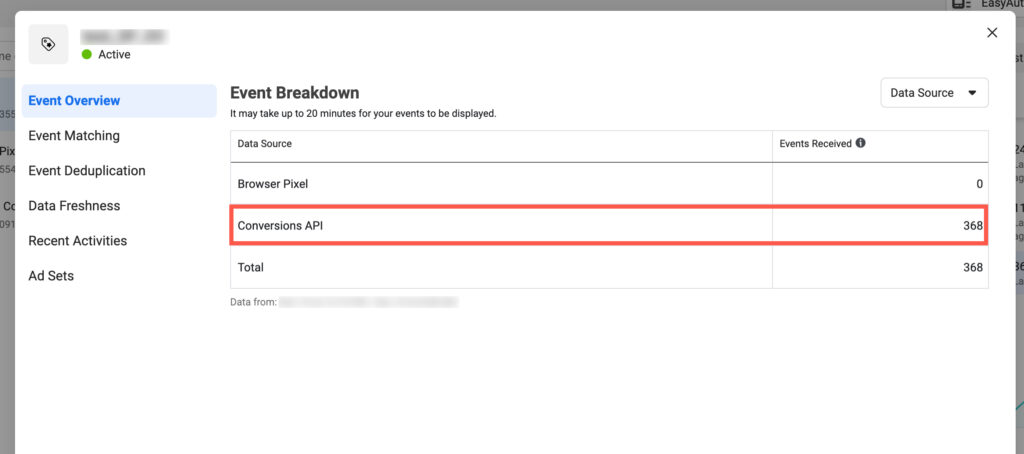
Adding SaaS B2B Events to the Facebook Ads Manager for Reporting
Custom events only become available for reporting in the as manager after they have been added to an active conversion objective campaign.
To add your new custom SaaS B2B Facebook Ads events to the Facebook Ads Manager for reporting go to Columns > scroll down to Customize Columns > Select the new custom, standard or existing custom event as one of your conversion columns.
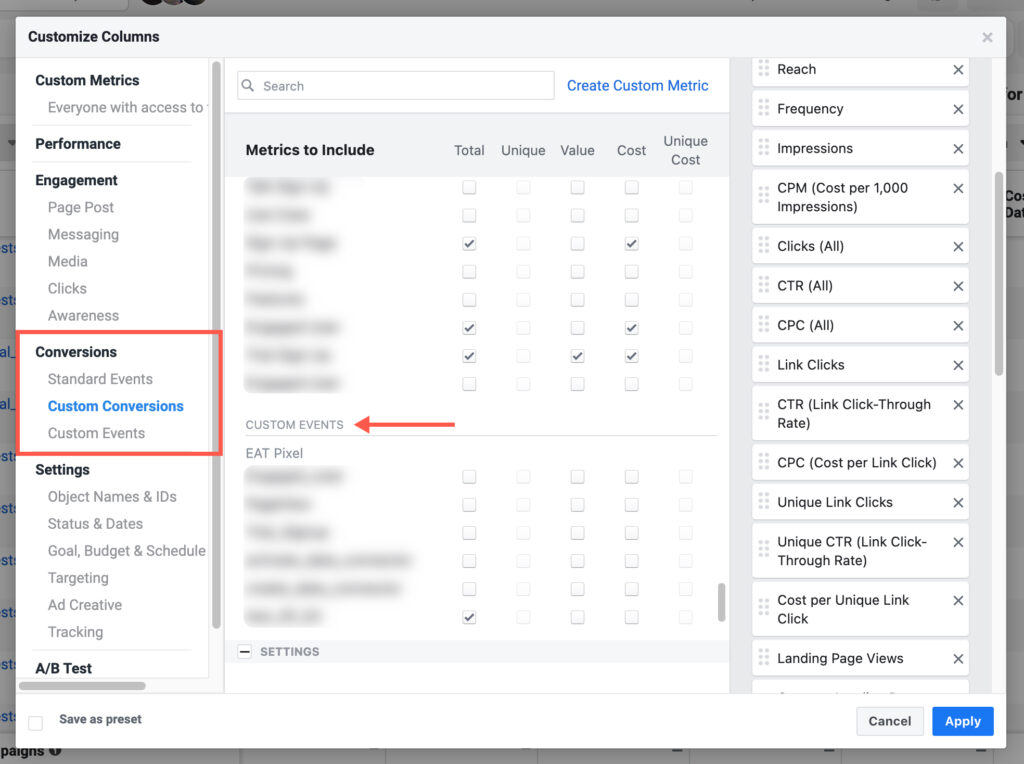
Conclusion
Running SaaS B2B Facebook Ads with a manual pipeline feedback loop is limiting. However, creating a real-time value-based pipeline feedback loop and optimizing for quality leads produces a successful SaaS B2B Facebook Ads strategy that can scale 📈.
You can learn more about ConversionStream and its Salesforce Integration here.
AUTHOR BIO:
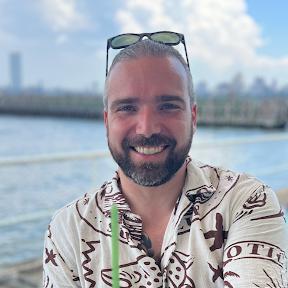
With over a decade of digital marketing experience, Gabriel excels in search, display, and social advertising across various industries. He specializes in performance media and data-driven storytelling, building custom digital ecosystems that enhance user experiences across both paid and owned channels. Connect with Gabriel on LinkedIn or explore more of his articles here.
Leave a comment